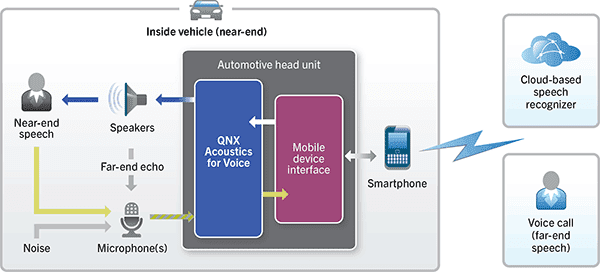 |
| Tina Jeffrey |
What is QNX Acoustics for Voice?
QNX Acoustics for Voice 3.0 is the successor to the QNX Aviage Acoustics Processing Suite 2.0. The new product includes a set of libraries — standard and premium — that offer automakers ultimate flexibility for voice processing in the harsh audio environment of the car.
The standard library provides a full-featured solution for implementing narrowband and wideband hands-free communications, operating at 8 kHz and 16kHz sample rates, respectively. It also includes innovative new features for performing echo cancellation, noise reduction, adaptive equalization, and automatic gain control. Perhaps the most valuable feature, especially for systems constrained by limited CPU cycles, is the high efficiency mode, which can process wideband and higher-bandwidth speech with substantially less CPU load. The net result: more processing headroom for other tasks.
The premium library includes all the standard library functionality, plus support for Wideband Plus, which expands the frequency range of transmitted speech to 50 Hz - 11 kHz, at a 24kHz sample rate. The introduction of Wideband Plus fulfills the higher voice quality and low noise requirements demanded by the latest smartphone connectivity protocols for telephony, VoIP services, and speech recognition. Let me recap with a table:
Supported capabilities | Standard library | Premium library |
Narrowband audio: 300 – 3400Hz (8kHz sample rate) | ✔ | ✔ |
Wideband audio: 50-7000Hz (16kHz sample rate) | ✔ | ✔ |
Wideband Plus audio: 50Hz – 11kHz (24kHz sample rate) | ✔ | |
High efficiency mode | ✔ (Wideband only) | ✔ |
VOIP requirements for new smartphone connectivity protocols | ✔ | |
Cloud-based speech recognition requirements for new smartphone connectivity protocols | ✔ |
Why is high-quality speech important in the car?
Simply put, it improves the user experience and can benefit passenger safety. Also, new smartphone connectivity protocols require it. Let’s examine two use cases: hands-free voice calling, and speech recognition.
In a voice call, processing a larger bandwidth of speech and eliminating echo and noise from various sources, including wind, road, vents, fans, and tires, dramatically increases speech intelligibility — and the more intelligible the speech, the more natural the flow of conversation. Also, clearer speech has less impact on the driver’s cognitive load, enabling the driver to pay more attention to the task at hand: driving.
Speech recognition systems are becoming a primary way to manage apps and services in the car. Voice commands can initiate phone calls, select media for playback, search for points of interest (POI), and choose a destination.
Technological advancements in pre-processing voice input to remove noise and disturbances helps speech recognizers detect commands more reliably, thereby achieving higher recognition accuracy. Early speech recognition systems, by comparison, were unintuitive and performed poorly. Drivers became so frustrated that they stopped using these systems and resorted to picking up their smartphones, completely eliminating the safety benefits of speech recognition.
 |
| QNX Acoustics for Voice 3.0 is a comprehensive automotive voice solution that includes industry-leading echo cancellation, noise reduction, adaptive equalization and automatic gain control. |
If you happen to be at Telematics Update in Novi Michigan this week, be sure to drop by our booth to sit in our latest concept car — a specially modified Mercedes-Benz CLA45 AMG — and experience our acoustics technologies first hand.
No comments:
Post a Comment